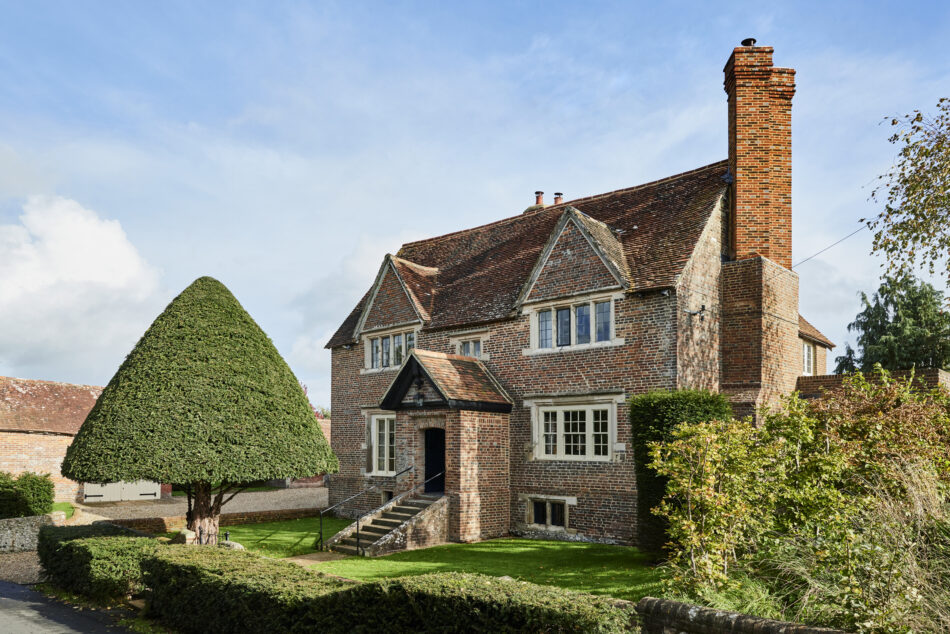
This wonderful Grade II*-listed five-bedroom house near Lewes in East Sussex was built c.1640. Full of historical detail, such as oak beams and inglenook fireplaces, the house has been lovingly and comprehensively restored, conjuring up the mood of the past while being perfectly designed for modern living. Externally, there are sweeping landscaped grounds of about an acre, as well as ancillary buildings. Set on the edge of the charming village of Ripe, the house has fast access to London, with trains running from Lewes (taking just over an hour) every 30 minutes; Gatwick airport is a 40-minute drive away or a 34-minute train journey.
Setting the Scene
Originally built for the wealthy Acton family (buried in the village church graveyard), the house on Ripe Lane would have been state of the art when it was built in the 1640s. The house originally comprised a brewhouse, fish pool, dairy and bakery. It was not until the 1680s when William Action came into a considerable inheritance, that he decided to add a brick porch to the façade, which still bears the initials ‘WA’. Noted in Pevsner’s Guide to East Sussex for its historical and architectural significance, the house has a couple of so-called ‘witches’ marks’, engravings common in the 17th century, thought at the time to protect against evil spirits.
The current owners commissioned a complete history of the building by acclaimed author Fiona Rule, listing every owner and resident since the house was built, a copy of which will be left with the house. For more information, please see the History section.
The Grand Tour
A flight of steps, flanked by two large topiary specimens, leads to a covered brick porch and the square-headed, iron-studded front door, both added in the 1680s. This opens to an entrance hall flanked by the two main reception rooms. The charming main sitting room has an inglenook fireplace with a multi-fuel stove inset. Dual-aspect windows illuminate the room and overlook the front and side gardens. Exposed beams run overhead, with a 17th-century witches mark carved into one. On the opposite side of the plan is a large dining room, finished in ‘Calke Green’ by Farrow and Ball, which contrasts beautifully with the dark oak beams with a further multi-fuel stove.
At the back of the house is the light-filled kitchen, with cabinetry by Plain English painted in ‘Light Bronze’ by Little Greene. The walls are finished in ‘String’, again by Farrow and Ball, and the original brewhouse floor with red quarry tiles remains underfoot. An energy-efficient two-oven economy 7 electric Aga has been fitted, and there is a useful pantry set in the corner of the room; restored oak beams run overhead. There is also a utility room with an adjoining cloakroom off the main hall.
The back of the hall has been painted a warming ‘Orange Aurora’ by Little Greene and leads to a snug and a library. The snug overlooks the lawns and has a further wood-burning stove.
The first floor is home to four bedrooms. Two at the front of the plan are en suite, and either could be used as the main bedroom. In both, the exposed beams continue, and there are views over the quiet Ripe Lane. At the back of the plan are two further bedrooms and a family bathroom. One of the bedrooms is fitted with another multi-fuel stove.
On the second floor, the eaves are open to showcase the house’s exceptional oak beams. A dramatic space full of history, there is currently a dressing room, a bedroom and a study space.
There is parking for several cars on the gravelled driveway with an electric vehicle charging point.
The Great Outdoors
Externally, the current owners have focused on creating a sculptural landscape with topiary and lawns, drawing the eye to various alfresco dining areas and spots for quiet reflection. A pond is located on the footprint of the original 1640s fish pool. Ancillary buildings, including a garage and an outhouse, offer space for potting and surplus garden tools. The front of the house has topiary and lawns leading on to Ripe Lane.
Out and About
Ripe is a charming village with a shop serving locally produced food from their cafe and a post office within walking distance. The immediate area is home to a wealth of cultural amenities, including Charleston Farm House, the country home of the Bloomsbury Set, which has an annual literature festival and arts events throughout the year. Also nearby are Farley Farm House, Glyndebourne Opera and the Rathfinny Wine Estate. The South Downs National Park is nearby, as is the East Sussex coast, with seaside towns such as Eastbourne, Hastings, Brighton and Hove all close.
There is much to do in the nearby Lewes, a 15-minute drive away. There are plenty of independent shops, antiquarian bookshops and several antique markets. There are numerous cafes, such as Patisserie Lewes and Flint Owl Bakery, and galleries, including The Star Brewery Gallery and the Needlemakers. There are also many independent businesses that stock work by local craftspeople. A new cinema and art complex, The Depot, shows various mainstream and arthouse movies. Lewes Castle is a wonderful local landmark with stunning panoramic views across Sussex from the top of the fortification.
Ripe is well connected with Lewes station a fifteen-minute drive away, with direct trains to Clapham Junction and London Victoria in just over an hour and Gatwick airport in 34 minutes.
Council Tax Band: H
History
Mentioned in the Domesday Book, Ripe was originally part of the land owned by King Harold II, killed in the battle of Hastings, who at the time was Earl Harold Godwinson. It was later owned by Richer, the Norman lord of L’Aigle. The Parish church is also mentioned in Pope Nicholas IV’s Taxatio Ecclesiastica of 1291.
Ripe developed around two specific historic cores; the crossroads in the centre of the village and Eckington corner in the east. Lying within a historic Roman landscape of centuriated fields (still visible) and ancient trackways, Ripe is of significant historical importance. With minimal architecturally modern interventions, the village is now a conservation area recognised for its aesthetic and historical merit.
Interested? Let’s talk
Related Listings
- A Private View: A slate-clad structure completes this personal family portrait in LambethHomes / Interiors
- A Room of One's Own: Mary Graham's nostalgic country house bedroomA room of ones own / Homes / Interiors
- A Room of One's Own: Fee Greening's bewitching shepherd's hut in rural DorsetA room of ones own / Homes / Interiors
- A Private View: A Roman relic rises from the ruins in CaerwentHomes
- Cottage Craving: five storybook dwellings that capture the quintessence of cosyHomes

